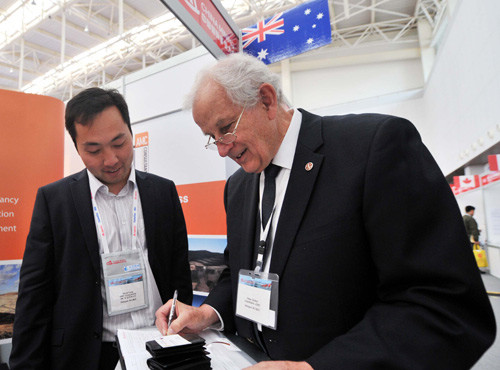|
 |
|
MINING DEVELOPMENT: An Australian businessman speaks with a Chinese mining consultant on November 5 during the China Mining Conference and Exhibition 2012 held in Tianjin (YUE YUEWEI) |
For the video please click here
2012 marks the 40th anniversary of diplomatic relations between the People's Republic of China and Australia. During the last four decades, the bilateral relationship has progressed by leaps and bounds. In a recent interview with Beijing Review, Australian Ambassador to China Frances Adamson shared her views on the booming relationship as well as bilateral cooperation in regional affairs. Excerpts follow:
Beijing Review: What are the legacies from four decades of Sino-Australian diplomatic relations?
 Frances Adamson: Since the two sides signed the joint communiqué on December 21, 1972, we have seen dramatic growth in all sorts of aspects of the relationship—dramatic growth in trade, in investment, in tourism, in students' exchange, in cooperation, and in some of the things that one cannot count in terms of quantity. But you can certainly get a sense in terms of the quality of the relationship. I'd like particularly to highlight four areas where I think we have seen very substantial, changing development in the last 40 years. Frances Adamson: Since the two sides signed the joint communiqué on December 21, 1972, we have seen dramatic growth in all sorts of aspects of the relationship—dramatic growth in trade, in investment, in tourism, in students' exchange, in cooperation, and in some of the things that one cannot count in terms of quantity. But you can certainly get a sense in terms of the quality of the relationship. I'd like particularly to highlight four areas where I think we have seen very substantial, changing development in the last 40 years.
The first is business. We have got from 1972 when bilateral trade was about AU$100 million (Australian dollars being roughly equivalent to U.S. dollars) to today when data show bilateral trade has reached over AU$150 billion. In the area of investment, in the last five years, the Australian Government approved 380 investment proposals from Chinese companies, most of which are state-owned companies, worth over AU$81 billion.
In education and science, the number of Chinese students studying in Australia reached 167,000 in 2010. What I want to highlight is the very strong science collaboration that has been developing between universities and research institutes in Australia and their Chinese counterparts. And we now have so many of these relationships that they are almost impossible to count.
Another is collaboration in culture. I think the importance of Chinese culture within China is well known. Many Chinese have an understanding of Australian indigenous culture and its 40,000-year history. Both countries have also found in each other some interesting modern culture to exchange and to appreciate in addition to the long-standing history that they enjoy.
I also want to mention the development of tourism. Chinese short-term visitors to Australia in 1972 were fewer than 500, but the number in 2011 reached 542,000. In the meantime, Australian short-term visitors to China in 1972 were also very few, but the number in 2010 was more than 336,000.
The Australian Government issued a white paper titled Australia in the Asian Century in October. Why does Australia emphasize its Asian identity?
Geographically, Australia is part of the Asia-Pacific region, and one has only to look at the map to see at least part of the answer to that question. Another part of the answer lies in the trade force: Over a period of decades Australia has become increasingly interconnected with countries of this region, particularly the Asian region, through normal trade forces.
We have talked about the importance of natural resources that are a big part of that relationship. But then if you look at investment flows, traditionally they came to us from Europe and the United States, but for many years now Japan and South Korea have been significant sources of investment in Australia, and China now is gradually becoming more important.
And then if you overlay on the top of that the flows of people—students, tourists and business people, Australia also is a very multicultural place. We had a census in August last year, which showed that we had a population of 22 million people; 860,000 are of Chinese origin. Mandarin, after English, is the most frequently spoken language in Australia. Of course, other countries in the Asian region similarly have now large communities in Australia and are very connected in this region.
But part of the title of the white paper was just to reflect the reality of Asia's rise—not just the rise of China, but also the rise of India, the rise of ASEAN countries as a whole and the rise of Indonesia, one of Australia's closest neighbors. Some of this is just the realities of the century. When you look globally at where economic activities have been generated, it is in Asia.
| 